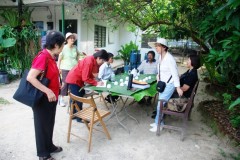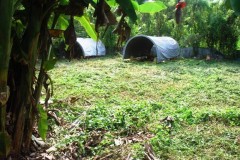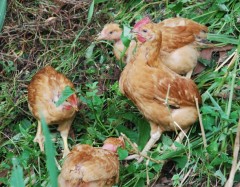Jun 07, 2010
Visitors to the Farm - Lily Fu and Ramleans
Youthful 'senior', Lily Fu and her fellow 'Ramleans' came for a visit last week.
They set the mood for the day right by being 15 mins early. BTW the plastic bags you see in Lily's blog are made from biodegradable material and we provide them only for 'seniors'.
We enjoyed seeing their reaction when sampling our fruits. Non-clone, slow growing fruits and vegetables do taste better and are nutritionally superior!!
10:23 Posted in Visitors | Permalink | Comments (0) | Tags: ramlea, ramleans, lily fu, seniorsaloud
May 28, 2010
Visitors to the Farm - May, 2010




15:21 Posted in Visitors | Permalink | Comments (0) | Tags: fama, malaysia best, dato kok wee kiat
May 24, 2010
Raising Free Range Chickens - Watch That Water!!!
People ask me what is the most important thing that they have to watch out for in successful free-range poultry raising in Malaysia and I always answer : water!
Watch out for water in the litter
Water in the reban
Water under the reban
Water in the padang
Watch out for leaking pipes, even in the fields as the birds will drink from the leaked water which will become contaminated from the dung.
Watch out for the temperature of the water - it must always be colder than the surrounding air.
Above all the farm must be dry. With our humidity, a wet farm will raise humidity to 70% plus. That will bring with it many diseases.
We shape the land by creating swales, retention ponds and contours to move rain water to areas away from the fields and coops.
But sometimes the volume is just too great and we have no choice but to cut the earth and make drains. This is what happened to us over the weekend. There was a sudden huge downpour and the chicken fields were flooded. One particular field with marketable size chickens was flooded 3 feet and 407 chickens drowned. That's a revenue loss of about RM8000.
Mud everywhere blocking off culverts and drains.
A drain buried in mud.
A field covered with mud.
We had no alternative but to dig a huge earth drain to handle similar volume in future.
The weather at the farm have changed in the past few years and coupled with land clearing nearby, the farm has become a focal point of run-offs from these cleared areas.
Though the work was tiring, the workers were cheerful. they had fun catching the many wild eels in the farm for their lunch and dinner.





19:54 Posted in Chickens | Permalink | Comments (0) | Tags: hoop house, free-range chickens, crd, poultry disease, free range poultry system, grassfed chickens
May 19, 2010
Proud Farmer II
Around the Klang Valley are literally hundreds of small farms producing vegetables and fruits for the insatiable appetite of city residents.
These farms are mainly unsupervised and are farmed mostly by immigrants, legal or otherwise. Buyers will come and load up and take them to the wholesale markets. At the wholesale markets, retailers will come to cart off their selections to sell them at pasar malam(s), stalls and other retail outlets.
Smaller buyers will come to the farms too, to buy and sell them to nearby restaurants where you have your weekend holiday meals (for the 'freshness' of the meats and vegetables).
We decided to visit one such farm situated right next to a stream feeding a river further down. The farmer is very proud of his produce which looks appetizing, fresh, healthy with no insect or fungal damage. It is sold at nearby restaurants and also taken to the main wholesale market in the Klang Valley.
The farm is situated in a picturesque location where senior government and corporate officials often come to take their break or to attend seminars and training courses.


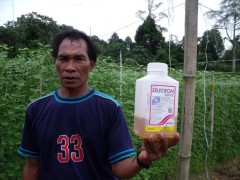



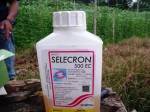

He explains that he sprays the vegetables with insecticides every 3 days right up to harvest.
He gave us some samples to take back.
The vegetables reek.
Note:
The farmer is illiterate.
One of the chemicals he uses is a paraquat. Just two teaspoons of paraquat will kill a man. Read here on paraquat.
The insecticide he uses every 3 days until harvest is an organophosphate (OP). Read here on OP and here. OP has been implicated in some Parkinson's or Parkinson's like diseases.
Paraquat and OP are controlled items and require permits to purchase. Unlicensed farms are obtaining these chemicals through illegal means.
May 17, 2010
Proud Farmer I
Look At What Our Compost Did!!!
We grew a watermelon variety that normally ripens at around 2 to 3 kg (easier to sell, we thought).
Look at what our compost have done to the fruits:




10:38 Posted in Blog | Permalink | Comments (0) | Tags: compost tea, bio nutrients, watermelon, organic fruits, organic farming
May 13, 2010
Sustainable Goat Production System - A Model
Red meat is considered bad for you. But this was not the case 50 years ago. There were tribes then, and still, who consume mainly meat and live normal healthy lives. Some eskimos eat only meat throughout their lives. Nomadic people used to consume only the meat and milk of the animals they herd.
Perhaps the problem lies with how we raise the animals. Here's the lipids content of a sample cut of 100 grams taken from the USDA nutrients database:
Beef - saturated fat: 9.75gms, omega 6: 2.56gms, omega 3: Nil, Cholesterol: 90 mg
Lamb - saturated fat: 11.76gms, omega 6: 2.08gms, omega 3: Nil, cholesterol: 74mg
Chicken - saturated fat 2.6gms, omega 6: 1.87gms, omega 3: 0.03gms, cholesterol: 64mg.
The chicken sample had an oddity, trans fat of 0.105gms. Wonder what are they feeding the chickens, recycled frying oil?
Compare the above with the goat meat produced from our farm:
Saturated Fats : 0.3gms, Omega 6: 140mg, Omega 3: 49.6mg, Cholesterol 51.
The non-existence of omega 3 in industrialised meats as per the samples from the USDA database is worrying for consumer health. The chicken had an omega 6 omega 3 ratio of 62:1. Our goat meat has a ratio of 3:1.
Read here why a low ratio is important for your health.
This is how we produce our goat meat. The goats are happy, the land is happy, the consumer is healthy.
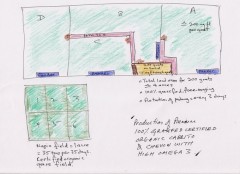

The goats are moved from field to field every 3 to 7 days. This reduces disease and intestinal worm problems.





Grass is planted separately, harvested, and fed to the goats. This ensures better utilization of land and thereby reduce the demand for expanding land acreage.
An acre of land using normal grazing methods can raise a maximum 15 goats. In our case, we can raise 200 goats on an acre of land.
With less disease and better control on the quality of grass that the goats are eating, the net result is happy goats, healthier meat for the consumers and less impact on the environment.
We are the only producer of red meat that can guarantee an omega 6: omega 3 ratio of 4:1 or better (in the world!).
15:18 Posted in Goats | Permalink | Comments (1) | Tags: goat farming, sustainable goat farming, pasture management, omega 6 omega 3 ratio
May 10, 2010
Raising Free Range Chickens - Leave The Ammonia Behind!
Many readers write to us asking about diseases affecting their birds. However, many of these problems have to do with basic management, in particular the formation of ammonia(1) in their coops.
Initial signs of excessive ammonia include eye irritation and trachea and lung problems.
Subsequent to that, secondary infection sets in - mycoplasma for one, leading to chronic respiratory disease. Another common poultry problem is coryza resulting in a mad rush for antibiotics. Coryza, in the Malaysian context is often the result of exposure to ammonia which corrodes the mucous membrane allowing pathogens to gain entry into the body.
So the root cause is excessive ammonia and the solution to many diseases with symptoms like gasping, coryza, swollen eyes, etc is to manage ammonia production in your poultry system, rather than treat the end-result all the time, resulting in the abuse of antibiotics.
Ammonia production also leads to environmental issues - flies, smell, leachate, etc.
At our farm, we decided on a movable hoop house:
The hoop house design encourages air movement. The temperature difference within / outside the house can be as high as 2 degrees celcius.
The hoop house is moved every 7 to 10 days. During dry spells, 10 days. During rainy seasons, every 7 days. Feeders and waterers are moved every 3 days. Don't let dung and discarded food accumulate to form ammonia.
Lay down the bedding material.
The house can be pulled by one man if the move is on flat land. If it needs to be lifted, then two men is required.
Note that the old floor have been covered with dried grass to start the in-situ composting. In no time, humus will be formed.
Each hoop house is designed to shelter 300 800grams chickens from the sun and rain.
The house is moved in less than 15 mins. The chickens have clean fresh beds instantly. No necessity to remove litter and top up litter, etc resulting in labour and material costs savings.
DQ'S GOLDEN RULE : MOVE THE HOUSE, MOVE THE FEEDERS!! LEAVE THE AMMONIA BEHIND!!
Resulting in healthy, happy, nutritious chickens:
Birds are moved to the hoop house when they are 800 grams in size.
(1) The formation of ammonia is part of the natural process in the breakdown of organic material. Ammonium is poisonous and often wipe out a newly established aquarium of its fish. Industrial animal husbandry often raise animals in ammonia prone conditions - poultry, feedlotted cattle wading in their own dung, etc. Waste water from farms with animals often contain nitrites and nitrates which can also harm humans. At our farm all discharge is treated naturally and regularly tested for nitrite and nitrate levels as part of responsible farming.
17:13 Posted in Chickens | Permalink | Comments (1) | Tags: hoop house, free-range chickens, crd, poultry disease, free range poultry system, grassfed chickens
May 05, 2010
Tonic for Chickens
Some of the readers of this blog have asked me to write more on natural poultry rearing methods. This post is for readers of citypullagro and lopehpoultry and other poultry blogs.
At our farm we use this tonic for the chickens:
We use a large glass jar ('balang'). Do not use plastic. Here's the receipe:
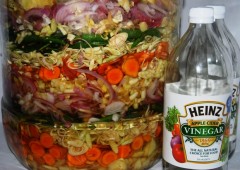
To Use
Indications
Notes:
17:50 Posted in Chickens | Permalink | Comments (4) | Tags: ayam kampung, poultry disease, poultry tonic, poultry medication
Apr 30, 2010
Watermelon on Raised Beds
People don't grow watermelons on raised beds. That's what they told us.
Right, and that's why, we supposed, conventionally grown local watermelon have such a bad reputation for pesticides and fungicides!
It's logical, our climate is humid and wet, not really ideal for watermelon.
Further, local weeds will overwhelm the watermelon plant in days. So if we plant them on the ground then its logical that pests, fungal diseases and weeds must be kept at bay using a cocktail of chemicals - 3 in one!! :)
This is the raised bed we used:
Four bricks high, layer of compost at the bottom and filled to the brim with sand.
If you are planning to grow on a larger scale, do not use bricks, they are not really practical. Recycle discarded tires - just stack up two.
Lush watermelon plants fed farm-made compost tea once a week.
Heavy, succulent fruits on the way.
Things will go wrong, just don't throw out the baby with the bath water.
There are many possible reasons why the watermelon plant may not do well. Try to investigate, keep records, and modify and adapt.
One of the most common reasons is wrong seed. You will be surprised how often this mistake is made. Seeds from Japan, Taiwan, etc are not suited for growing naturally in our climate though they may thrive doing so in their home countries. We need to duplicate the conditions back home but that's not a route that sustainable farming should take.
11:05 Posted in Permaculture | Permalink | Comments (0) | Tags: raised beds, key hole garden, permaculture, watermelon
Apr 28, 2010
Outsmarting a wild boar...
Wild boar is a perpetual problem at our farm. They break through fencing and get at the chickens, they dig up all those lovely yams and sweet potatoes, they damage our vegetable plots digging up earthworms for desert.
All kinds of suggestions have been given to us; shoot them, poison them, trap them, etc. We reject outright killing. Trapping, etc never works; they're too wary.
Then they played with this beautiful pegaga patch and turned it into a mud-bath:
We were too distraught to remember to take a picture of the mud-bath.
We rehabilitated the patch twice but each time the pigs came in and turned it into mud again.
Then we sat and decided to think like a pig: it's dark, we can't look upwards to see the sky, we can only see directly in front, sideways and down. Now what if we see something totally dark in front would we be foolhardy enough to plunge ahead or would we move sideways looking for a path?
And we came up with this:
This was how the rehabilitated patch looked like after a week in the 'dark zone' (the red laterite mud has been topped with compost):
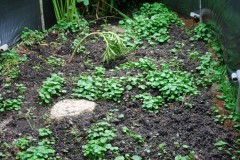
And this is signs of the pigs going in circles around the 'dark zone'. Note the mud!
And this is the patch today after two weeks. Warms the heart. The possibility are endless! And we don't have to take a life or lives to co-exist. Remember, a life is still a life.
18:47 Posted in Blog | Permalink | Comments (4) | Tags: wild boar, pigs, trapping a wild boar








